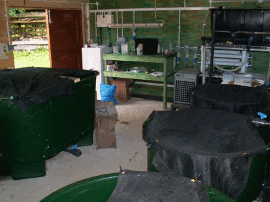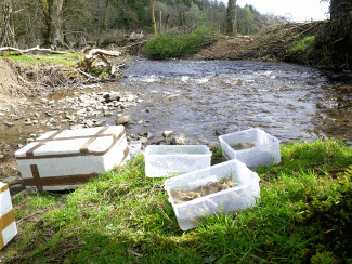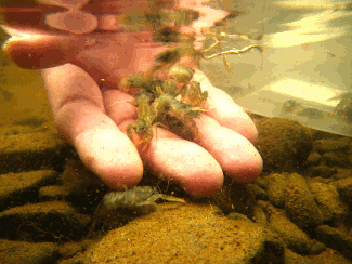Re-introduction of White clawed crayfish into designated streams

The White clawed crayfish survey confirmed a continued contraction in their range. This necessitated a change in approach for the action from translocation to captive breeding.
A culture system was constructed at Abercynrig hatchery, with the capacity to rear 1,000 juveniles for release. Water was sourced from a borehole and run through UV sterilisation to minimise risk of crayfish plague.
14 berried female broodstock were collected by hand from the Nant Fawr and the Escley brook in April and May 2011
Due to issues obtaining a licence from Natural England, collection from the Escley took place far later than hoped. As a result females were found to be carrying juveniles rather than eggs. Due to potential risk of shedding juveniles during transport a decision was taken to remove only two animals. On arrival at the culture unit it was found that only one juvenile had been shed from the two females.
The females were held in tanks with refuge provided in the form of lengths of 2 inch and 1.5 inch pipe. They were fed twice weekly with a mixture of cat food, bloodworm and mixed vegetable matter.
To ensure any hatching juveniles had sufficient food, live artemia was fed sparingly every two days as of the 11 June. In early July independent juveniles were spotted in the tanks at which point feeding was stepped up to a daily ration of artemia along with frozen cyclops. As the juveniles grew, the feeding regime changed accordingly with artemia and cyclops phased out and replaced with daphnia and different sizes of bloodworm.
Shortly after the juveniles were observed, the adult females were removed from the holding system to prevent maternal cannibalisation.
There were teething problems that lead to survival issues in 2 tanks but in May 2012, 600 x 0+ juveniles were introduced directly into a recently improved section of the middle Chwefru.


Releasing the juveniles into the Chwefru
